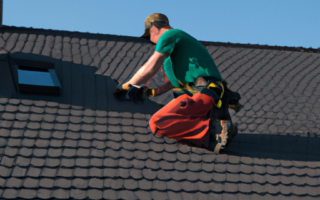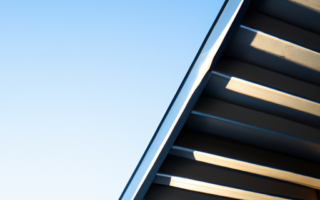Exploring New Trends in Roof Construction: Adapting to Modern Designs and Technologies
Exploring New Trends in Roof Construction: Adapting to Modern Designs and Technologies
Roof construction methods and materials have come a long way in recent years, with innovative designs and technologies revolutionizing the way roofs are built. These advancements not only enhance the aesthetic appeal of buildings but also improve their energy efficiency and durability. In this article, we will explore some of the new trends in roof construction that are shaping the modern architectural landscape.
One of the key trends in roof construction is the use of sustainable and eco-friendly materials. With an increasing focus on environmental conservation, architects and builders are opting for materials that have a minimal impact on the planet. Green roofs, for example, are gaining popularity as they provide insulation, reduce stormwater runoff, and create urban oases. These roofs are typically covered with vegetation, which adds beauty to the building while promoting sustainability.
Another trend in roof construction is the integration of solar panels. As the demand for renewable energy rises, solar-powered roofs have become a viable option for many homeowners and commercial building owners. These roofs are designed to capture sunlight and convert it into electricity, reducing reliance on traditional energy sources. Not only do solar roofs help in reducing carbon emissions, but they also generate significant cost savings in the long run.
The advancement in roofing technologies has also led to the development of innovative roof designs. Architects are now exploring complex shapes and forms, moving away from traditional pitched roofs. These new designs not only add a touch of uniqueness to buildings but also offer functional benefits. For instance, curved roofs are not only aesthetically pleasing but also better at withstanding wind loads, making them ideal for areas prone to high winds.
Furthermore, the use of lightweight and durable materials is gaining traction in roof construction. Materials like metal alloys and composites are being used to create strong yet lightweight roofs, which offer excellent resistance against various weather conditions. These materials are also easy to install, reducing construction time and costs.
Lastly, the incorporation of smart technologies into roof construction is a trend that holds immense potential. Smart roofs can regulate temperature, control lighting, and even generate data on energy usage. These roofs feature sensors and integrated systems that allow for remote monitoring and control, optimizing energy efficiency and creating a comfortable indoor environment.
In conclusion, the world of roof construction is witnessing exciting advancements in designs and technologies, with sustainability, efficiency, and aesthetics at the forefront. From eco-friendly materials and solar panels to innovative designs and smart technologies, these trends are shaping the roofs of the future.
Revolutionizing Roofing: Innovative Methods and Materials for Sustainable Construction
Revolutionizing Roofing: Innovative Methods and Materials for Sustainable Construction
In today’s world, sustainability has become a paramount concern for individuals, businesses, and communities. As the construction industry strives to reduce its environmental impact, innovative methods and materials are being developed to revolutionize roofing practices. These advancements not only provide more durable and efficient roofs but also contribute to a greener and more sustainable future.
One of the key aspects of revolutionizing roofing is the use of eco-friendly and sustainable materials. Traditional roofing materials, such as asphalt shingles and concrete tiles, have a significant carbon footprint and a limited lifespan. However, new materials such as recycled metal, recycled rubber, natural cedar shakes, and even solar panels are gaining popularity for their sustainable properties. These materials are not only durable but also offer improved energy efficiency and reduced waste generation.
Another innovative method revolutionizing roofing is the integration of green roofs. Green roofs are designed to incorporate vegetation, which helps improve air quality, reduce stormwater runoff, and provide insulation. They create a natural barrier against heat and cold, reducing the energy required for heating and cooling buildings. Moreover, green roofs also contribute to reducing the urban heat island effect, promoting biodiversity, and enhancing the aesthetic appeal of buildings.
Technology plays a crucial role in revolutionizing roofing as well. Advanced software and modeling tools now enable architects and engineers to design roofs with precision, maximizing energy efficiency and minimizing waste. Additionally, the integration of smart technologies in roofing systems allows for remote monitoring and control of various parameters, such as temperature, humidity, and energy consumption. These smart systems not only optimize the performance of roofs but also enhance overall building efficiency.
Furthermore, innovative construction methods are also transforming the way roofs are installed and maintained. Prefabricated roofing systems are gaining popularity as they offer faster installation times and reduce material waste on-site. Moreover, modular designs allow for easy replacement of damaged or worn-out components, extending the lifespan of the roof and reducing the need for full replacements.
In conclusion, the roofing industry is undergoing a significant transformation with the advent of innovative methods and materials. Sustainable and eco-friendly materials, the integration of green roofs, advancements in technology, and improved construction and maintenance techniques are revolutionizing roofing practices. These advancements not only lower the environmental impact of roofing but also provide more durable, energy-efficient, and visually appealing solutions. As the construction industry continues to prioritize sustainability, these innovations will continue to shape the future of roofing.
Embracing the Future: Cutting-Edge Roof Designs and Construction Techniques
The construction industry has been witness to a significant transformation in recent years, with a focus on embracing the future through cutting-edge roof designs and construction techniques. As technology continues to advance, architects, engineers, and contractors are exploring innovative methods to create roofs that are not only functional but also aesthetically pleasing and sustainable. This article explores some of the latest trends in roof construction, highlighting the use of modern designs and technologies.
One of the most notable trends in roof construction is the integration of green roofing systems. These systems involve the use of vegetation and plant life on the roof surface, providing numerous benefits such as improved insulation, reduced energy consumption, and enhanced stormwater management. Green roofs not only contribute to the overall sustainability of a building but also add beauty and natural aesthetics to the surrounding environment.
In addition to green roofing, the use of solar panels and renewable energy technologies on roofs has gained significant popularity. With the increasing focus on renewable energy sources, integrating solar panels into the roof design allows for efficient harnessing of solar power. This not only reduces the carbon footprint of a building but also offers long-term energy cost savings. Furthermore, advancements in solar panel technology have made them more efficient, durable, and aesthetically appealing, making them compatible with various roof designs.
Another emerging trend in roof construction is the use of lightweight materials. Traditionally, roofs were constructed using heavy materials such as concrete and metal, but modern designs have seen a shift towards lightweight alternatives. Lightweight roofing materials offer several advantages, including reduced structural load, easier installation, and increased flexibility in design. Materials such as composite shingles, polymer-based tiles, and insulated metal panels provide durability and aesthetic options while significantly reducing the overall weight on the structure.
Moreover, the incorporation of smart technologies into roof construction has revolutionized the industry. Sensor-enabled roofs can monitor environmental conditions, detect potential leaks or damage, and even control ventilation systems. This not only enhances the longevity and performance of the roof but also ensures energy efficiency and occupant comfort. Additionally, the integration of smart technologies allows for remote monitoring and maintenance, making roof management more convenient and cost-effective.
As the construction industry moves towards a sustainable and eco-friendly future, innovative roof designs and construction techniques play a pivotal role. Embracing the future means incorporating green roofing systems, utilizing solar panels and renewable energy technologies, opting for lightweight materials, and integrating smart technologies. By embracing these cutting-edge methods, buildings can achieve a harmonious balance between functionality, aesthetics, and sustainability.
Pushing the Boundaries: Exploring the Possibilities of Modern Roofing Innovation
Innovative roof construction methods have revolutionized the way we think about roofing design and technology. With the advancing modern techniques, architects and engineers are constantly pushing the boundaries of what is possible in terms of roofing innovation.
When it comes to exploring the possibilities of modern roofing innovation, the key lies in finding new and efficient ways to enhance the functionality and aesthetics of roofs. This involves incorporating cutting-edge materials, advanced construction techniques, and sustainable design principles.
One area where modern roofing innovation has greatly expanded is in the use of lightweight and durable materials. Traditional roof construction often relied on heavy materials such as concrete or clay tiles, which could limit design possibilities. However, the advent of materials like metal alloys, composite panels, and synthetic membranes has opened up a whole new world of design options.
These lightweight materials not only allow for more creative and complex roof shapes, but they also offer advantages in terms of durability and energy efficiency. Metal roofs, for example, are known for their longevity and resistance to extreme weather conditions. Composite panels can be designed to have excellent insulation properties, reducing the dependence on heating and cooling systems.
Roofing innovation also extends to the integration of sustainable technologies. Green roofs, for instance, are gaining popularity as a way to utilize otherwise unused rooftop space. These roofs are covered with vegetation, providing benefits such as improved air quality, stormwater management, and enhanced insulation. Solar panels and other energy-saving systems are also being incorporated into roof designs, allowing buildings to generate clean energy and reduce their carbon footprint.
Another aspect of modern roofing innovation is the incorporation of smart technologies. These technologies enable roofs to adapt to changing weather conditions, improving energy efficiency and overall comfort. For example, advanced sensors can detect rain and adjust roof angles to guide water towards designated drainage areas. Smart roof coatings can regulate temperature and reflect sunlight, reducing the need for air conditioning.
With all these advancements, it is clear that modern roofing innovation is pushing the boundaries of what is possible. Architects and engineers are continuously exploring new materials, techniques, and technologies to create roofs that are not only functional but also aesthetically pleasing and sustainable. As we move forward, it will be exciting to see how these innovations transform the way we design and construct roofs.



